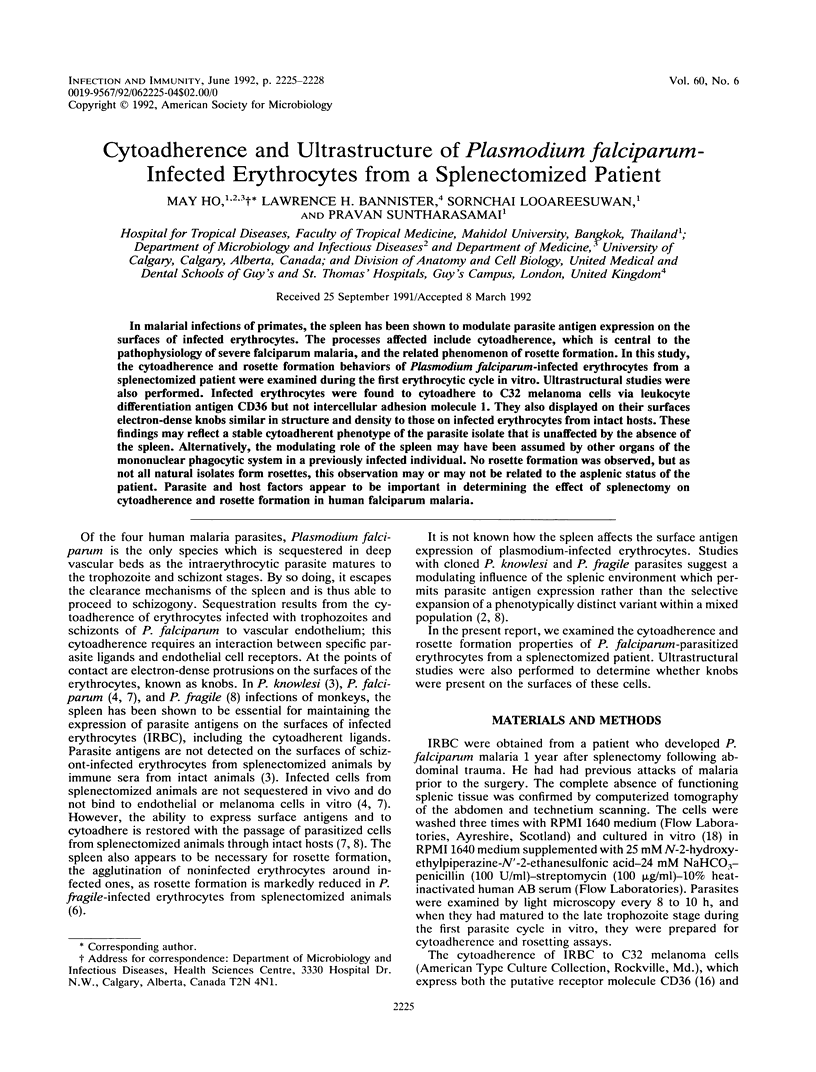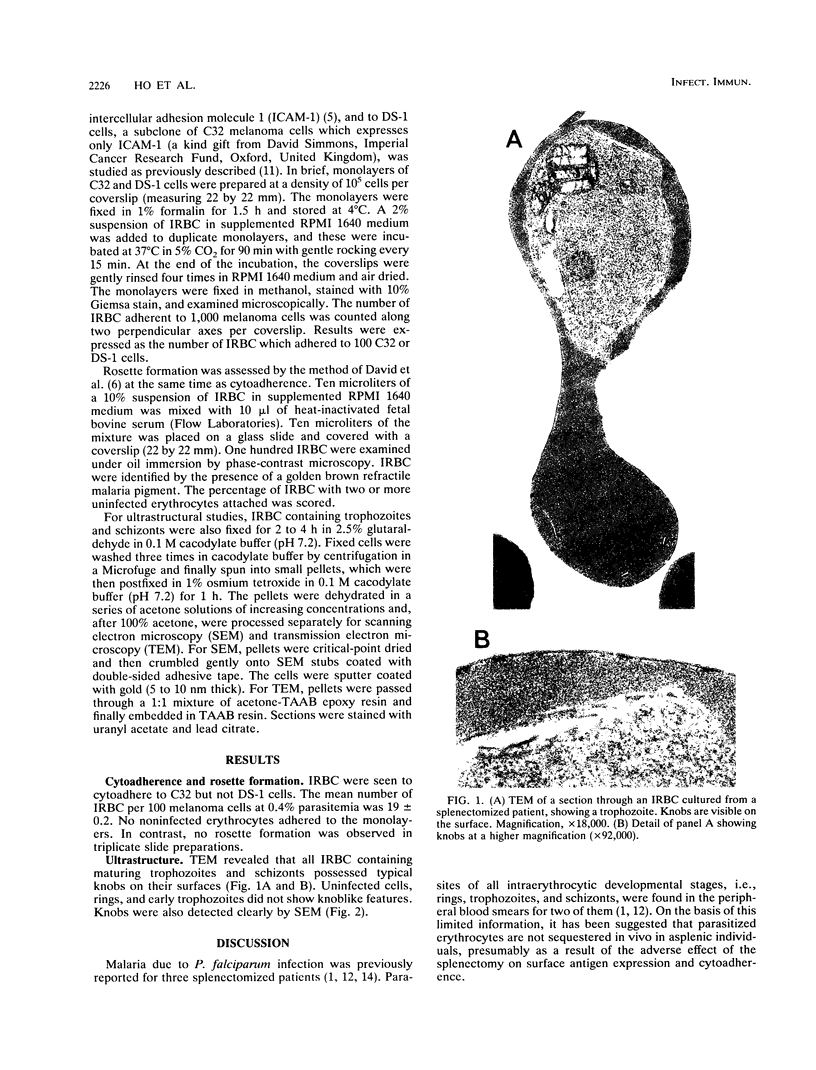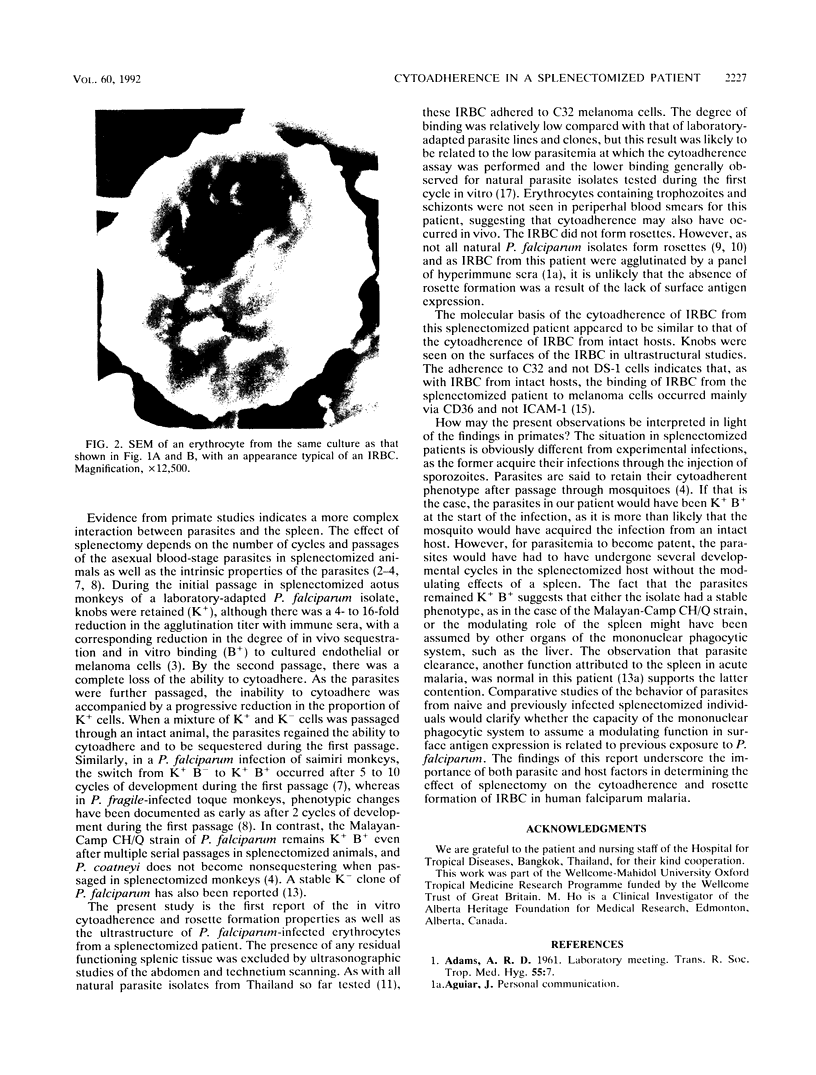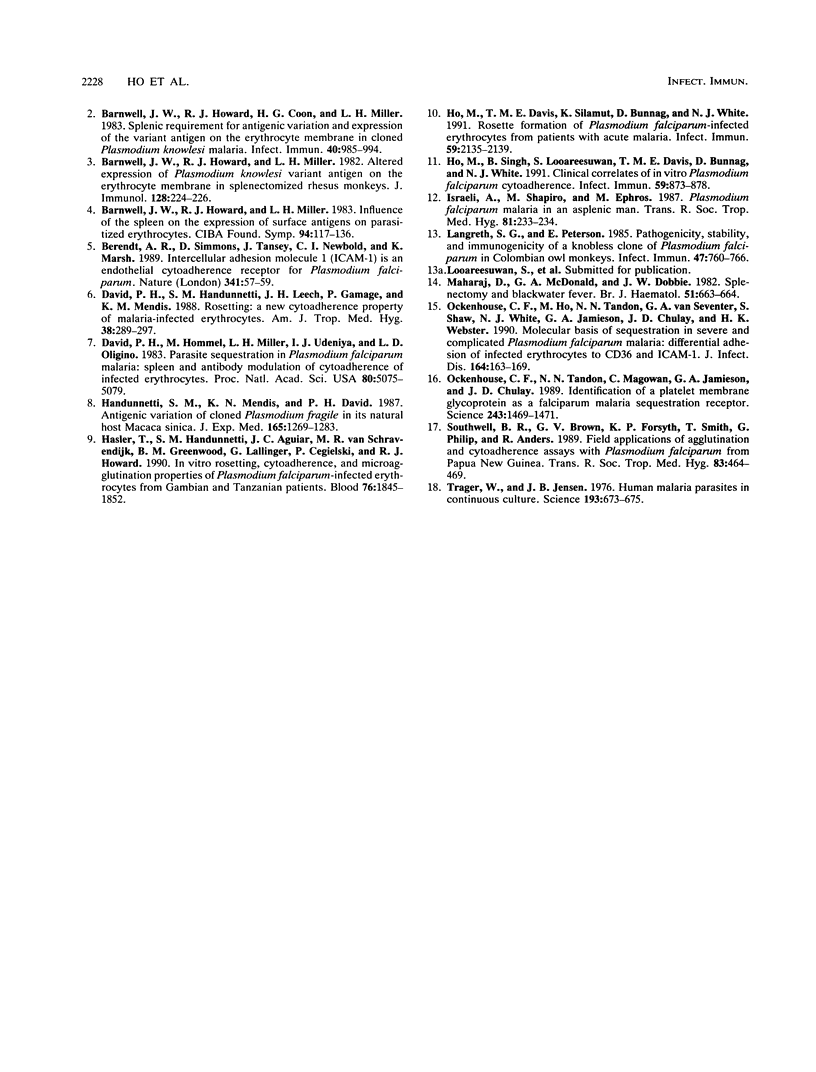Abstract
In malarial infections of primates, the spleen has been shown to modulate parasite antigen expression on the surfaces of infected erythrocytes. The processes affected include cytoadherence, which is central to the pathophysiology of severe falciparum malaria, and the related phenomenon of rosette formation. In this study, the cytoadherence and rosette formation behaviors of Plasmodium falciparum-infected erythrocytes from a splenectomized patient were examined during the first erythrocytic cycle in vitro. Ultrastructural studies were also performed. Infected erythrocytes were found to cytoadhere to C32 melanoma cells via leukocyte differentiation antigen CD36 but not intercellular adhesion molecule 1. They also displayed on their surfaces electron-dense knobs similar in structure and density to those on infected erythrocytes from intact hosts. These findings may reflect a stable cytoadherent phenotype of the parasite isolate that is unaffected by the absence of the spleen. Alternatively, the modulating role of the spleen may have been assumed by other organs of the mononuclear phagocytic system in a previously infected individual. No rosette formation was observed, but as not all natural isolates form rosettes, this observation may or may not be related to the asplenic status of the patient. Parasite and host factors appear to be important in determining the effect of splenectomy on cytoadherence and rosette formation in human falciparum malaria.
Full text
PDF



Images in this article
Selected References
These references are in PubMed. This may not be the complete list of references from this article.
- Barnwell J. W., Howard R. J., Coon H. G., Miller L. H. Splenic requirement for antigenic variation and expression of the variant antigen on the erythrocyte membrane in cloned Plasmodium knowlesi malaria. Infect Immun. 1983 Jun;40(3):985–994. doi: 10.1128/iai.40.3.985-994.1983. [DOI] [PMC free article] [PubMed] [Google Scholar]
- Barnwell J. W., Howard R. J., Miller L. H. Altered expression of Plasmodium knowlesi variant antigen on the erythrocyte membrane in splenectomized rhesus monkeys. J Immunol. 1982 Jan;128(1):224–226. [PubMed] [Google Scholar]
- Barnwell J. W., Howard R. J., Miller L. H. Influence of the spleen on the expression of surface antigens on parasitized erythrocytes. Ciba Found Symp. 1983;94:117–136. doi: 10.1002/9780470715444.ch8. [DOI] [PubMed] [Google Scholar]
- Berendt A. R., Simmons D. L., Tansey J., Newbold C. I., Marsh K. Intercellular adhesion molecule-1 is an endothelial cell adhesion receptor for Plasmodium falciparum. Nature. 1989 Sep 7;341(6237):57–59. doi: 10.1038/341057a0. [DOI] [PubMed] [Google Scholar]
- David P. H., Handunnetti S. M., Leech J. H., Gamage P., Mendis K. N. Rosetting: a new cytoadherence property of malaria-infected erythrocytes. Am J Trop Med Hyg. 1988 Mar;38(2):289–297. doi: 10.4269/ajtmh.1988.38.289. [DOI] [PubMed] [Google Scholar]
- David P. H., Hommel M., Miller L. H., Udeinya I. J., Oligino L. D. Parasite sequestration in Plasmodium falciparum malaria: spleen and antibody modulation of cytoadherence of infected erythrocytes. Proc Natl Acad Sci U S A. 1983 Aug;80(16):5075–5079. doi: 10.1073/pnas.80.16.5075. [DOI] [PMC free article] [PubMed] [Google Scholar]
- Handunnetti S. M., Mendis K. N., David P. H. Antigenic variation of cloned Plasmodium fragile in its natural host Macaca sinica. Sequential appearance of successive variant antigenic types. J Exp Med. 1987 May 1;165(5):1269–1283. doi: 10.1084/jem.165.5.1269. [DOI] [PMC free article] [PubMed] [Google Scholar]
- Hasler T., Handunnetti S. M., Aguiar J. C., van Schravendijk M. R., Greenwood B. M., Lallinger G., Cegielski P., Howard R. J. In vitro rosetting, cytoadherence, and microagglutination properties of Plasmodium falciparum-infected erythrocytes from Gambian and Tanzanian patients. Blood. 1990 Nov 1;76(9):1845–1852. [PubMed] [Google Scholar]
- Ho M., Davis T. M., Silamut K., Bunnag D., White N. J. Rosette formation of Plasmodium falciparum-infected erythrocytes from patients with acute malaria. Infect Immun. 1991 Jun;59(6):2135–2139. doi: 10.1128/iai.59.6.2135-2139.1991. [DOI] [PMC free article] [PubMed] [Google Scholar]
- Ho M., Singh B., Looareesuwan S., Davis T. M., Bunnag D., White N. J. Clinical correlates of in vitro Plasmodium falciparum cytoadherence. Infect Immun. 1991 Mar;59(3):873–878. doi: 10.1128/iai.59.3.873-878.1991. [DOI] [PMC free article] [PubMed] [Google Scholar]
- Israeli A., Shapiro M., Ephros M. A. Plasmodium falciparum malaria in an asplenic man. Trans R Soc Trop Med Hyg. 1987;81(2):233–234. doi: 10.1016/0035-9203(87)90224-0. [DOI] [PubMed] [Google Scholar]
- Langreth S. G., Peterson E. Pathogenicity, stability, and immunogenicity of a knobless clone of Plasmodium falciparum in Colombian owl monkeys. Infect Immun. 1985 Mar;47(3):760–766. doi: 10.1128/iai.47.3.760-766.1985. [DOI] [PMC free article] [PubMed] [Google Scholar]
- Maharaj D., McDonald G. A., Dobbie J. W. Splenectomy and blackwater fever. Br J Haematol. 1982 Aug;51(4):663–664. doi: 10.1111/j.1365-2141.1982.tb02834.x. [DOI] [PubMed] [Google Scholar]
- Ockenhouse C. F., Ho M., Tandon N. N., Van Seventer G. A., Shaw S., White N. J., Jamieson G. A., Chulay J. D., Webster H. K. Molecular basis of sequestration in severe and uncomplicated Plasmodium falciparum malaria: differential adhesion of infected erythrocytes to CD36 and ICAM-1. J Infect Dis. 1991 Jul;164(1):163–169. doi: 10.1093/infdis/164.1.163. [DOI] [PubMed] [Google Scholar]
- Ockenhouse C. F., Tandon N. N., Magowan C., Jamieson G. A., Chulay J. D. Identification of a platelet membrane glycoprotein as a falciparum malaria sequestration receptor. Science. 1989 Mar 17;243(4897):1469–1471. doi: 10.1126/science.2467377. [DOI] [PubMed] [Google Scholar]
- Southwell B. R., Brown G. V., Forsyth K. P., Smith T., Philip G., Anders R. Field applications of agglutination and cytoadherence assays with Plasmodium falciparum from Papua New Guinea. Trans R Soc Trop Med Hyg. 1989 Jul-Aug;83(4):464–469. doi: 10.1016/0035-9203(89)90248-4. [DOI] [PubMed] [Google Scholar]
- Trager W., Jensen J. B. Human malaria parasites in continuous culture. Science. 1976 Aug 20;193(4254):673–675. doi: 10.1126/science.781840. [DOI] [PubMed] [Google Scholar]




